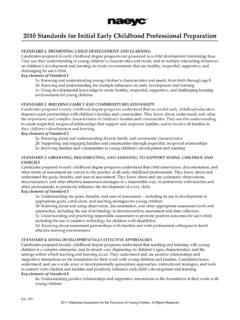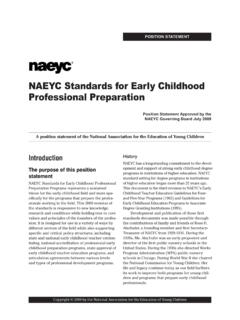Transcription of Evidence-Based Assessment of Conduct Disorder: Current ...
1 Evidence-Based Assessment of Conduct Disorder: Current Considerations and Preparation forDSM-5 Christopher T. BarryThe University of Southern MississippiFarrah N. GolmaryamiThe University of New OrleansNicole Rivera-HudsonThe University of Southern MississippiPaul J. FrickThe University of New OrleansThis article provides a review of research on the etiological and developmental factors involved in childconduct problems broadly and Conduct disorder (CD) specifically. The implications of this research forevidence-based Assessment of CD are discussed, and an update to previous discussions of evidence-basedassessment in anticipation of the fifth edition of theDiagnostic and Statistical Manual of Mental Disorders(DSM-5) is provided. Assessments of persons with CD must be guided by research which points to theheterogeneity within those with the disorder in terms of the severity of their behavioral problems and potentialcausal factors. Assessments must also recognize the importance of developmental onset for the conceptual-ization and planning of interventions.
2 The discussion also centers on the relative advantages and disadvantagesof different informants and tools in the Assessment process for children with Conduct : Conduct disorder, Assessment ,DSM-5 Despite a recent emphasis on developing models of Evidence-Based Assessment for child and adolescent psychopathology (seeMash & Hunsley, 2005), many unresolved issues remain includingwhat specific measures are necessary and/or sufficient for accurateassessments that inform treatment. The goal of having Evidence-Based models for clinical Assessment of various presenting prob-lems is well-founded, but a clear model remains elusive. Withoutsuch models, assessments are subject to the idiosyncrasies of theclinician and/or the setting in which they are being clinical judgment is a necessary component of psycho-logical evaluations (Mash & Hunsley, 2005), children and theirfamilies are much better served by an approach that is grounded onempirical knowledge and the systematic gathering of evidence toanswer a referral question (Frick, Barry, & Kamphaus, 2010).
3 Prior work has discussed unique challenges in the Assessment ofchild Conduct problems ( , oppositional defiant disorder [ODD]and Conduct disorder [CD]; McMahon & Frick, 2005). Foremostamong these challenges is the need to evaluate the numerous formsthat Conduct problems may take and the need to align treatmentrecommendations to a child or adolescent s specific Current paper has two aims. First, the paper summarizes andsynthesizes the extant evidence on the etiology, development, andphenomenology of CD with reference to the proposed fifth editionof theDiagnostic and Statistical Manual of Mental Disorders(DSM-5) criteria for CD. Second, the paper discusses how thisresearch can inform a sound, empirically grounded, and efficientassessment of CD in light of the proposed criteria. The relativeadvantages and disadvantages of various Assessment tools are alsodiscussed in terms of their psychometric properties, ease of ad-ministration, and ability to inform diagnostic decisions and treat-ment should be noted that this discussion is based primarily onthose assessments conducted in outpatient settings when there is aninitial referral question or a need for reevaluation based on achild s behavioral or emotional functioning.
4 Thus, for these typesThis article was published Online First July 9, BARRY received his PhD in clinical psychology fromThe University of Alabama. He is an Associate Professor in the Depart-ment of Psychology at The University of Southern Mississippi. His re-search interests are in the areas of risk and protective factors for childconduct problems, adolescent narcissism, and GOLMARYAMI received her BS in psychology from TheUniversity of Southern Mississippi. She is a doctoral student in the De-partment of Psychology at the University of New Orleans. Her researchinterests include pathways to child/adolescent developmental psychopa-thology and the role of social context on child/adolescent antisocial be-havior and her BS in psychology from the Uni-versity of Central Florida. She is a doctoral student in the Department ofPsychology at The University of Southern Mississippi. Her research inter-ests involve how intrapersonal factors are related to the maintenance andexacerbation of adolescent Conduct problems and FRICK received his PhD in clinical psychology from the Uni-versity of Georgia.
5 He is the Chair of the Department of Psychology andis a University Distinguished Professor at the University of New research interests are on understanding the dispositional and contextualfactors that place children and adolescents at-risk for several antisocial andviolent behaviors, lead to diagnoses of Conduct disorder, or arrests forillegal FRICKis an author of a rating scale (APSD) published byMulti-Health Systems discussed in this paper and has a financial interest inthe sale of this CONCERNING THIS ARTICLE should be addressed toChristopher T. Barry, 118 College Dr., Box 5025, Hattiesburg, MS : Psychology: Research and Practice 2012 American Psychological Association2013, Vol. 44, No. 1, 56 630735-7028/13/$ DOI: Assessment , careful consideration of the child s symptoms asthey pertain to diagnostic criteria is a central focus. In morerestrictive settings ( , residential, inpatient, juvenile justice), thepresence of an emotional or behavioral disorder (including CD)may have already been documented.
6 The central focus in thesesettings may instead be making an expeditious determination ofthe appropriate intervention strategies or level of care. Neverthe-less, the important developmental and contextual factors discussedherein, as well as the relative advantages and disadvantages of theassessment tools used to evaluate important variables in the pre-sentation of CD, are largely similar across settings. To mostappropriately make intervention recommendations regardless ofthe setting in which an Assessment is conducted the clinicianmust be able to translate the research on the phenomenology andcauses of CD into Assessment practice and treatment is characterized by a repetitive and persistent pattern ofbehavior in which the rights of others and age-appropriate culturalnorms are violated (American Psychiatric Association, 2000). Thebehaviors that constitute CD are varied and include aggressiontoward people and animals ( , bullying and fighting others,physically harming pets), destruction of property ( , deliberatefire setting, vandalism), deceitfulness or theft ( , breaking andentering, lying for personal gain), and serious violation of rules( , school truancy, running away; American Psychiatric Asso-ciation, 2000).
7 CD can lead to an enduring course of antisocialbehavior, criminal activity, and other problems in adjustmentacross the life span, including mental health problems ( , sub-stance abuse), educational problems ( , school dropout), socialproblems ( , poor peer relations), occupational problems ( ,poor job performance), and physical health problems (see Odgerset al., 2007, 2008).Thus, knowledge of the etiology and course of this disorder isimportant for understanding and preventing a host of problematicoutcomes. Perhaps the major issue in advancing etiological re-search is in determining how to best capture the great heteroge-neity of persons with CD. Specifically, youth with CD can differgreatly on the course of the disorder and in the potential causalprocesses leading to the disorder. As a result, there have been anumber of proposed methods for classifying important subgroupsof youth with CD, with the proposedDSM-5criteria for CD beingdirectly informed by existing Proposed byDSM-5 Conduct Disorder: Implications for Evidence-Based AssessmentIn theDSM IV, CD was divided into childhood -onset andadolescent-onset subtypes, based on whether the first CD symptomemerges before age 10 (American Psychiatric Association, 2000).
8 Although questions remain about the utility of this specific agecut-off and the best method for assessing age of onset, there hasbeen sufficient evidence to support retaining this distinction in theDSM-5(Frick & Nigg, 2012), as a greater severity and persistenceof problems have been tied to childhood -onset CD compared withadolescent-onset CD (see Moffitt & Caspi, 2001). The majorchange being proposed in theDSM-5criteria for CD is the additionof a specifier to designate youths With a callous-unemotionalpresentation (American Psychiatric Association, 2012). To re-ceive this specifier, the youth must meet criteria for CD and showtwo or more callous-unemotional (CU) characteristics, which in-clude a lack of remorse or guilt, lack of empathy, unconcern overperformance in important activities, and/or shallow affect, persis-tently for at least 12 months across multiple settings and relation-ships (American Psychiatric Association, 2012). The implicationsof these methods of subtyping youths with CD are : childhood -Onset Versus Adolescent-OnsetResearch indicates that age of onset is an important marker ofdifferent etiological factors involved in manifestation and progno-sis of behavioral problems (Frick & Viding, 2009; Moffitt, 1993;Odgers et al.)
9 , 2008). A summary of the correlates of each devel-opmental trajectory is presented in Table 1. Each of the associatedfeatures listed in Table 1 can provide valuable insight to theclinician for case conceptualization and treatment suggests that childhood -onset CD has a poorer prog-nosis and is associated with greater risk of antisocial behavior,violence, and criminality in adulthood (Odgers et al., 2008). Thus,Table 1 Associated Features of early vs. Late Onset of Conduct ProblemsAEarly ( childhood )Late (adolescence)NeuropsychologicalDeficits in executive function, low intelligenceNo clear neuropsychological deficitsTemperamental/PersonalityCU traits, impulsivity, fearlessness, emotionaloverreactivityRebelliousness and rejecting of traditionalstatus hierarchiesContextualGreater family dysfunction, poverty/lowsocioeconomic statusDelinquent peer affiliationsBehavioralAggression, higher severity and persistence ofconduct problems, higher likelihood of adultantisocial behaviorHigher likelihood of desisting in adulthoodDevelopmental processesTransactional between difficult temperament anddysfunctional or inadequate rearing contextsleading to problems in emotional regulation,poor executive control of behavior.
10 Orproblems in conscience developmentExaggeration/disruption of the developmentalprocess of adolescent identity formationGenderMales 10 times more likely than females toexhibit early onset CDMales times more likely than females toexhibit late onset CDASee Frick and Viding (2009) and Moffitt and Caspi (2001) for an extensive review of the research on this Assessment OF CONDUCTage of onset is a crucial variable in the Assessment of CD and inintervention planning. Age of onset also signals the need to exploreother likely contributing factors to the child s presentation. Forexample, a clinician should not only directly inquire about the ageof onset but may also assess for the neurodevelopmental difficul-ties ( , executive dysfunction, problems in emotional regulation)that have been associated with an early onset of Conduct youth with a later onset of Conduct problems, the clinicianshould evaluate factors such as the degree and quality of parentalsupervision and the degree of deviant peer affiliations.

